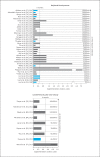Effectiveness of Vitamin D Supplementation for Cardiovascular Health Outcomes
- PMID: 28229054
- PMCID: PMC5290441
- DOI: 10.1159/000452742
Effectiveness of Vitamin D Supplementation for Cardiovascular Health Outcomes
Abstract
There is a plausible physiological theory, supported by many observational studies, that vitamin D supplementation should be effective for improving cardiovascular end points, such as blood pressure (BP), large artery stiffness, atherosclerosis, endothelial function and clinical events. However, results from randomised controlled trials (RCTs) have been inconsistent. In this review, we evaluated the evidence regarding the effectiveness of vitamin D supplementation for cardiovascular surrogate and hard clinical end points. RCTs were assessed in terms of sample size, duration of supplementation, baseline vitamin D level inclusion criteria (i.e., absence of vitamin D deficiency), dosage of vitamin D and population under investigation. Forty-five RCTs were identified. Eight RCTs with BP and 6 RCTs with large artery stiffness as the end points were found to comply with guidelines for the optimal design of clinical trials evaluating nutrient effects. Only 2 of the RCTs with an optimal design were effective in decreasing BP with vitamin D supplementation, although these were of moderate sample size (<150) and very short duration (8 weeks for both), whilst no RCT was effective in reducing large artery stiffness. Similar results were observed for atherosclerotic and endothelial function markers as end points. Only 1 RCT reported cardiovascular events as an end point and found neither increased nor decreased incident cardiovascular events over 7 years of follow-up. In conclusion, results from published RCTs indicate that vitamin D supplementation is ineffective in improving cardiovascular health among various patient populations, including in the presence or absence of vitamin D deficiency.
Keywords: Blood pressure; Cardiovascular health; Large artery stiffness; Randomized controlled trials; Vitamin D supplementation.
Figures



References
-
- Gunton JE, Girgis CM, Baldock PA, Lips P. Bone muscle interactions and vitamin D. Bone. 2015;80:89–94. - PubMed
-
- Tetlow LC, Woolley DE. Expression of vitamin D receptors and matrix metalloproteinases in osteoarthritic cartilage and human articular chondrocytes in vitro. Osteoarthr Cartilage. 2001;9:423–431. - PubMed
-
- Norman PE, Powell JT. Vitamin D and cardiovascular disease. Circ Res. 2014;114:379–393. - PubMed
-
- Rahman A, Hershey S, Ahmed S, Nibbelink K, Simpson RU. Heart extracellular matrix gene expression profile in the vitamin D receptor knockout mice. J Steroid Biochem Mol Biol. 2007;103:416–419. - PubMed
-
- Wu-Wong JR, Nakane M, Ma J. Vitamin D analogs modulate the expression of plasminogen activator inhibitor-1, thrombospondin-1 and thrombomodulin in human aortic smooth muscle cells. J Vasc Res. 2007;44:11–18. - PubMed
Publication types
LinkOut - more resources
Full Text Sources
Other Literature Sources

